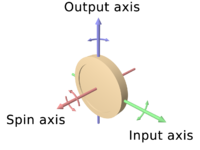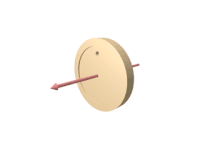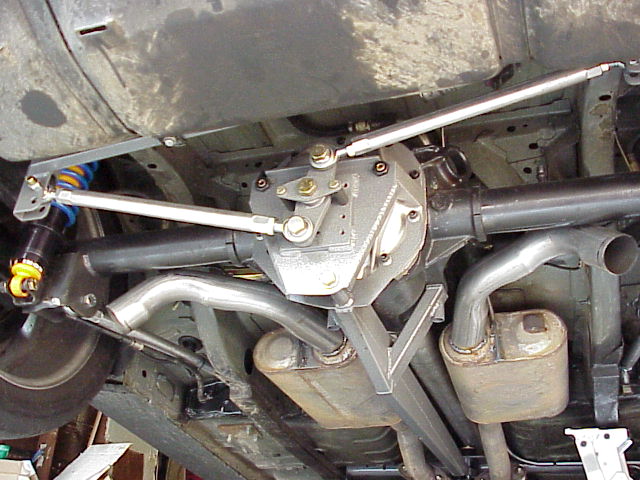Well, you brought some memories. You know, I had this otolaryngologist that clipped my tonsils, a woman friend of my mom. I was maybe 16 years old, and she was a total MILF and she knew it, and I knew that she knew it, and she knew that I knew it, but I digress... I'm not going to tell THAT story.
She had a boyfriend, kind of playboyish. He was nuts for old cars, he even had a Model T, first and only time I drove one.
Anyway, I helped him to paint a Bugatti 35 many, many, many, many years ago. The car wasn't his car, some banker honcho gave it to him for restoration.
While we worked, (well, "we" is perhaps too many people) he explained in detail how elliptical springs and a live axle helped the car to turn in flat roads (no bump, please) and, yes, when I finally was able to take it for a very short ride, it was astounding.
Few cars I've known can steer better than this car on a smooth road, a car with a live axle and an ancient design. I don't think this car has more than 100 hp, but the handling! Oh, my, the handling, sigh.
It moved the rear as some girls: you always knew where it was going, but you couldn't believe it. My "racing buttocks" were ecstatic, if you pardon this way of expressing myself.
I repeat:
it had one of the most perfect rear handling I've felt, even when I've compared (in my mind! I was 16) with modern suspensions and I drive a BMW with Z-axle multilink. Let me tell you: it has the same feeling, no drifting at all in the back (you know that HORRIBLE drifting sensation of the tyres in a solid axle kart when you don't lift the inner rear wheel?).
Now, the memories came because
he could talk for hours about the gyroscopic effect in the live axle that helped the car to turn, but I did not pay attention, to be sincere. I knew what gyroscopic effect was, but for the life of me I couldn't understand what he said nor how a gyroscope have something to do with a rear axle.
Besides, I was totally concentrated on learning to paint back then because, boy, this man was a perfectionist if you can find one and I made a few mistakes.
What I can tell you is that this axle was LOW. You couldn't go over a brick without carrying it with you, which was funny, because many people use live axles off-road for the constant clearance between road and differential, when compared with independent suspensions. At least that's what some people has said to me when you ask why they have converted independent suspension jeeps back into live axles at off-road competitions.
I can also tell you this: I remember well that the front leaf springs went
through the front axle. Funny, I've never seen that again.
To give this a conclusion (I've been accused of imprecision and digression! The nerve some people has!) I have the haziest idea of the particulars of this suspension, but
given the fact that this car is the undisputed world champion of races won in all history, you could find some inspiration. I think you can find literature about this car and, who knows, perhaps disinter something Ettore knew and that has been forgotten about this incredible suspension. Yeah, I know, leaf springs... but, who knows.
So, go and check a Type 35 suspension drawings, it shouldn't be that hard to find (argentinians have been churning out replicas for decades!) and maybe there is something. Something
has to be there and probably few remember (I mean, "algo tiene que haber ahí y pocos se acuerdan, ché"). Or maybe I'm exaggerating a little (although I swear I haven't exaggerated in... the last hundred years).
Finally, I know that people that race in strips with live axles use a different trailing arm, with harder bushes, to keep the pinion angle constant. Like this (it took a long google to get this image, but I think you know the idea already).
The pinion angle is the angle between the rear shaft and the diferential (when seen from the side). On the left, the problem, on the right, the solution: the tailshaft is "straight" or "parallel to the floor"

A harder bush in the trailing arm helps to keep the angle at a little less than 90 degrees (under power, it will give you, hopefully, 90 degrees). People uses polyurethane bushes. When the bushes wear, the differential wobbles and you lose traction so they go for harder ones. I've seen people arguing about this angle (2 degrees? Or 88 degrees, depending on how you measure it).
So, perhaps that's why you need "ballast": it's not for the sake of steering around the curve, I think it is for the sake of differential "stability". The lighter the diff, the more it wobbles, or so I believe (but I believe many things).
Which leads me to understand (at last!) while I write this post how the gyroscopic effect can help the unloaded wheel. When you power the car, the rear axle "sinks" toward one side, because the spinning rear axle change its vector for angular moment. After all, as you probably know, in a gyroscope spinning around the red vector, the vector of the output reaction (in blue) correspond to the vector of the input angular moment (in green), like this:

Here is the animation (remember, the vectors are not forces, but angular moments, they show the axis which the thing turns around, not the direction of its movement. Notice that you can "incline the rear axle". You have to imagine the rear right wheel to the
left of the disk and the rear left wheel to the
right of the disk, which represents the rear axle but "compressed" in a disk)
This should be confusing enough for everybody to think they understand! Actually, I'm so confused that I think I do.

I think (vaguely) this sense of rotation will load the inner wheel on clockwise circuits! I might be wrong. Perhaps you can measure the effect in a racing rig, have you access to one? Here they are very common and they give you the weight in each tyre (you can measure the effect in a car standing, if it has "free wheel" atachments, like in some jeeps, so the axle rotates but the wheels don't... or if the rig has rollers, well, you could measure it in any car and give some numbers to the drivers).
Notice that you could ask yourself if a spinning dead weight attached to the pinions would give you any advantage you wish in loading the wheels AND towards the side you wish... or design. Going totally nuts, you could even imagine a clutch that gives you the spinning or sinking you want, when you want it (making this dead weight to spin or stopping it). It would be a kind of active suspension.
I hope this doesn't diminish my reputation of
extreme lack of clarity... I'm proud of it.
 marcush:
marcush: Wow. Rollcenter underground? That's new to me. Beautiful.
donskar: solid axles? Isn't that a heresy? I cannot understand why you could use them. Could you explain a bit? You lose torsion rigidity by square law when you approach the center, isn't it? So, why would you want to put material at the center?









